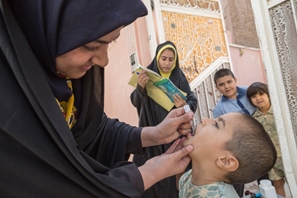 A child receives the oral polio vaccine. Photo: WHO/G.ElhamKabul 27 February 2017 - The Ministry of Public Health, together with WHO and UNICEF, launched today the second round of Sub-National Immunization Days (SNIDs) campaign of 2017 in high-risk areas to vaccinate 5.6 million children under age of 5 against polio. The campaign will be conducted in all provinces in the Southern and South-eastern regions, most districts in the Eastern region as well as selected high-risk districts across the country, including Kabul city.
A child receives the oral polio vaccine. Photo: WHO/G.ElhamKabul 27 February 2017 - The Ministry of Public Health, together with WHO and UNICEF, launched today the second round of Sub-National Immunization Days (SNIDs) campaign of 2017 in high-risk areas to vaccinate 5.6 million children under age of 5 against polio. The campaign will be conducted in all provinces in the Southern and South-eastern regions, most districts in the Eastern region as well as selected high-risk districts across the country, including Kabul city.
The campaign will run for three days, during which over 36 000 polio workers will go from house to house in their communities to vaccinate children. On Friday polio teams will revisit households where children were missed the first time the vaccinators visited to ensure that all children are vaccinated and protected.
“Polio causes permanent disability or even death. It is the right of all Afghan children to grow up healthy and we are all responsible to ensure that all children under the age of 5 receive two drops of the polio vaccine during every single vaccination campaign. Only by reaching all children with these life-saving vaccines can we eradicate polio from Afghanistan for good,” said H.E. Dr Ferozuddin Feroz, Minister of Public Health.
The polio vaccine is safe and it does not have any side effects even for sleeping, sick and newborn children. Polio vaccines are halal and have been specifically endorsed by Islamic scholars, including the Ulama, around Afghanistan.
Afghanistan, Pakistan and Nigeria are the only countries in the world where polio is still circulating. Two polio cases have been reported in 2017, one from Helmand and one from Kandahar. In 2016, 13 polio cases were reported, down from 20 in 2015. Most of Afghanistan remains polio-free, but wild poliovirus continues to circulate in localized geographical areas in the eastern, southern and south-eastern parts of the country.



